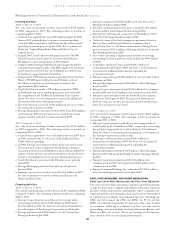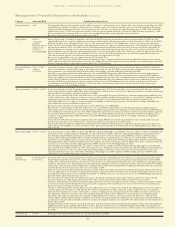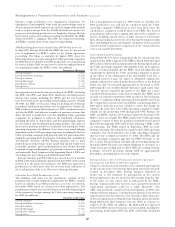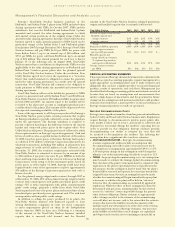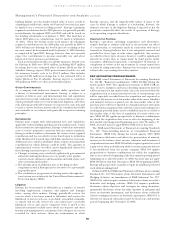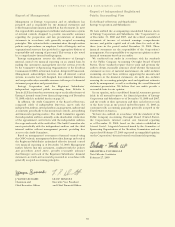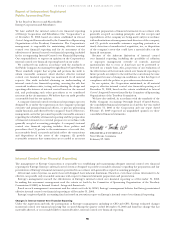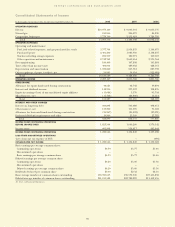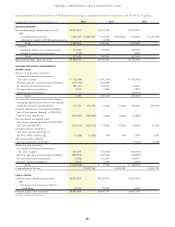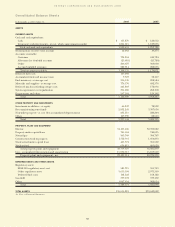Entergy 2008 Annual Report Download - page 52
Download and view the complete annual report
Please find page 52 of the 2008 Entergy annual report below. You can navigate through the pages in the report by either clicking on the pages listed below, or by using the keyword search tool below to find specific information within the annual report.
50
ENTERGY CORPORATION AND SUBSIDIARIES 2008
50
Management’s Financial Discussion and Analysis continued
Entergy’s Non-Utility Nuclear business’ purchase of the
FitzPatrick and Indian Point 3 plants from NYPA included value
sharing agreements with NYPA. In October 2007, NYPA and the
subsidiaries that own the FitzPatrick and Indian Point 3 plants
amended and restated the value sharing agreements to clarify
and amend certain provisions of the original terms. Under the
amended value sharing agreements, Entergy’s Non-Utility Nuclear
business agreed to make annual payments to NYPA based on the
generation output of the Indian Point 3 and FitzPatrick plants
from January 2007 through December 2014. Entergy’s Non-Utility
Nuclear business will pay NYPA $6.59 per MWh for power sold
from Indian Point 3, up to an annual cap of $48 million, and
$3.91 per MWh for power sold from FitzPatrick, up to an annual
cap of $24 million. The annual payment for each year is due by
January 15 of the following year. In August 2008, Non-Utility
Nuclear entered into a resolution of a dispute with NYPA over the
applicability of the value sharing agreements to its FitzPatrick and
Indian Point 3 nuclear power plants after the planned spin-off
of the Non-Utility Nuclear business. Under the resolution, Non-
Utility Nuclear agreed not to treat the separation as a “Cessation
Event” that would terminate its obligation to make the payments
under the value sharing agreements. As a result, after the spin-off
transaction, Non-Utility Nuclear will continue to be obligated to
make payments to NYPA under the amended and restated value
sharing agreements.
Non-Utility Nuclear will record its liability for payments to NYPA
as power is generated and sold by Indian Point 3 and FitzPatrick.
Non-Utility Nuclear recorded a $72 million liability for generation
in both 2008 and 2007. An amount equal to the liability will be
recorded to the plant asset account as contingent purchase price
consideration for the plants. This amount will be depreciated over
the expected remaining useful life of the plants.
Some of the agreements to sell the power produced by Entergy’s
Non-Utility Nuclear power plants contain provisions that require
an Entergy subsidiary to provide collateral to secure its obligations
under the agreements. The Entergy subsidiary is required to
provide collateral based upon the difference between the current
market and contracted power prices in the regions where Non-
Utility Nuclear sells power. The primary form of collateral to satisfy
these requirements is an Entergy Corporation guaranty. Cash and
letters of credit are also acceptable forms of collateral. At December
31, 2008, based on power prices at that time, Entergy had in place
as collateral $536 million of Entergy Corporation guarantees for
wholesale transactions, including $60 million of guarantees that
support letters of credit and $2 million of cash collateral. As of
December 31, 2008, the assurance requirement associated with
Non-Utility Nuclear is estimated to increase by an amount of up
to $216 million if gas prices increase $1 per MMBtu in both the
short- and long-term markets. In the event of a decrease in Entergy
Corporation’s credit rating to below investment grade, based on
power prices as of December 31, 2008, Entergy would have been
required under some of the agreements to replace approximately
$76 million of the Entergy Corporation guarantees with cash or
letters of credit.
For the planned energy output under contract through 2013 as
of December 31, 2008, 68% of the planned energy output is under
contract with counterparties with public investment grade credit
ratings; 31% is with counterparties with public non-investment
grade credit ratings, primarily a utility from which Non-Utility
Nuclear purchased one of its power plants and entered into a long-
term fixed-price purchased power agreement; and 1% is with load-
serving entities without public credit ratings.
In addition to selling the power produced by its plants, the
Non-Utility Nuclear business sells unforced capacity to load-
serving distribution companies in order for those companies
to meet requirements placed on them by the Independent
System Operator (ISO) in their area. Following is a summary
of the amount of the Non-Utility Nuclear business’ installed
capacity that is currently sold forward, and the blended
amount of the Non-Utility Nuclear business’ planned generation
output and installed capacity that is currently sold forward:
Non-Utility Nuclear 2009 2010 2011 2012 2013
Percent of capacity sold forward:
Bundled capacity and
energy contracts 26% 26% 26% 19% 16%
Capacity contracts 47% 34% 6% 9% 0%
Total 73% 0% 52% 28% 16%
Planned net MW in operation 4,998 4,998 4,998 4,998 4,998
Average capacity contract
price per kW per month $2.1 $3.4 $3.4 $3.2 $ –
Blended capacity and
energy (based on revenues)
% of planned generation
and capacity sold forward 86% 64% 43% 21% 14%
Average contract revenue
per MWh $63 $62 $59 $55 $50
CRITICAL ACCOUNTING ESTIMATES
The preparation of Entergy’s financial statements in conformity with
generally accepted accounting principles requires management to
apply appropriate accounting policies and to make estimates and
judgments that can have a significant effect on reported financial
position, results of operations, and cash flows. Management has
identified the following accounting policies and estimates as critical
because they are based on assumptions and measurements that
involve a high degree of uncertainty, and the potential for future
changes in the assumptions and measurements that could produce
estimates that would have a material effect on the presentation of
Entergy’s financial position or results of operations.
NU C L E A R DE C O M M I S S I O N I N G CO S T S
Entergy owns a significant number of nuclear generation facilities in
both its Utility and Non-Utility Nuclear business units. Regulations
require Entergy to decommission its nuclear power plants after
each facility is taken out of service, and money is collected and
deposited in trust funds during the facilities’ operating lives in
order to provide for this obligation. Entergy conducts periodic
decommissioning cost studies to estimate the costs that will
be incurred to decommission the facilities. The following key
assumptions have a significant effect on these estimates:
n COST ESCALATION FACTORS – Entergy’s decommissioning
revenue requirement studies include an assumption that
decommissioning costs will escalate over present cost levels
by annual factors ranging from approximately CPI-U to 5.5%.
A 50 basis point change in this assumption could change the
ultimate cost of decommissioning a facility by as much as 11%.
nTIMING – In projecting decommissioning costs, two assumptions
must be made to estimate the timing of plant decommissioning.
First, the date of the plant’s retirement must be estimated. The
expiration of the plant’s operating license is typically used for
this purpose, but the assumption may be made that the plant’s
license will be renewed and operate for some time beyond the
original license term. Second, an assumption must be made
whether decommissioning will begin immediately upon plant
retirement, or whether the plant will be held in “safestore”
status for later decommissioning, as permitted by applicable
regulations. While the effect of these assumptions cannot be
determined with precision, assuming either license renewal
or use of a “safestore” status can possibly change the present
value of these obligations. Future revisions to appropriately
reflect changes needed to the estimate of decommissioning
costs will affect net income, only to the extent that the estimate
of any reduction in the liability exceeds the amount of the
undepreciated asset retirement cost at the date of the revision,
for unregulated portions of Entergy’s business. Any increases
in the liability recorded due to such changes are capitalized
and depreciated over the asset’s remaining economic life in





